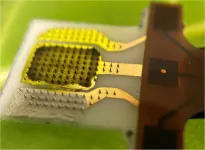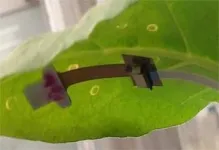Plant patch can detect stress signals in real time
2025-03-19
(Press-News.org) Environmental conditions can cause damaging stress to plants, posing challenges for home gardeners and farmers. Therefore, early detection — before leaves visibly discolor, wilt or wither — is crucial. Now, researchers reporting in ACS Sensors have created a wearable patch for plants that quickly senses stress and relays the information to a grower. The electrochemical sensor attaches directly to live plant leaves and monitors hydrogen peroxide, a key distress signal.
Pests, drought, extreme temperatures and infections all cause stress in plants. In response, plants’ normal biochemistry gets out of whack, and they produce hydrogen peroxide, which also acts as a signal between cells to activate their defense mechanisms. Early detection of this chemical clue could help people expertly tailor plant care and prevent further damage, thereby maximizing crop yields, even in difficult conditions. But most current methods for detecting hydrogen peroxide require removal of plant parts and multiple processing steps or external detectors that observe fluorescence changes, which can get muddled by chlorophyll. And researchers have previously investigated plant-wearable devices to monitor leaf water content as an indicator of plant health. So, Liang Dong and colleagues set out to design a stand-alone patch that quickly and accurately detects the hydrogen peroxide distress signals from living plants.
To build a patch that sticks to the underside of leaves, the researchers created an array of microscopic plastic needles across a flexible base. Onto this patterned surface they coated a chitosan-based hydrogel mixture that converted small changes in hydrogen peroxide into measurable differences in electrical current. The mixture contained an enzyme that reacted with hydrogen peroxide to produce electrons and reduced graphene oxide to conduct those electrons through the sensor.
The researchers tested their patches on live, healthy soybean and tobacco plants and compared them to stressed bacteria-infected plants. They found:
For both crops infected with the bacterial pathogen Pseudomonas syringae pv. tomato DC3000, the sensor produced more electrical current on stressed leaves than on healthy ones, and the current levels were directly related to the amount of hydrogen peroxide present.
The sensor’s measurement of hydrogen peroxide was accurate and confirmed by conventional lab analyses.
After about 1 minute, the patches measured hydrogen peroxide in the leaves at significantly lower levels than those previously reported from needle-like sensors for live plants.
Patches could be reused nine times before the microscopic needles lost their form.
The new strategy provides information that could help growers efficiently make decisions about their crops. “We can achieve direct measurements in under a minute for less than a dollar per test,” says Dong. “This breakthrough will significantly streamline analysis, making it practical for farmers to use our patch sensor for real-time disease crop monitoring.”
And the researchers are excited to continue moving the research forward. “Our next step is to refine the technology and enhance its reusability,” concludes Dong.
The authors acknowledge funding from Iowa State University, the U.S. Department of Agriculture’s National Institute of Food and Agriculture, and the National Science Foundation.
The paper’s abstract will be available on March 19 at 8 a.m. Eastern time here: http://pubs.acs.org/doi/abs/10.1021/acssensors.4c02645
###
The American Chemical Society (ACS) is a nonprofit organization founded in 1876 and chartered by the U.S. Congress. ACS is committed to improving all lives through the transforming power of chemistry. Its mission is to advance scientific knowledge, empower a global community and champion scientific integrity, and its vision is a world built on science. The Society is a global leader in promoting excellence in science education and providing access to chemistry-related information and research through its multiple research solutions, peer-reviewed journals, scientific conferences, e-books and weekly news periodical Chemical & Engineering News. ACS journals are among the most cited, most trusted and most read within the scientific literature; however, ACS itself does not conduct chemical research. As a leader in scientific information solutions, its CAS division partners with global innovators to accelerate breakthroughs by curating, connecting and analyzing the world’s scientific knowledge. ACS’ main offices are in Washington, D.C., and Columbus, Ohio.
Registered journalists can subscribe to the ACS journalist news portal on EurekAlert! to access embargoed and public science press releases. For media inquiries, contact newsroom@acs.org.
Note: ACS does not conduct research but publishes and publicizes peer-reviewed scientific studies.
Follow us: Facebook | LinkedIn | Instagram
END
[Attachments] See images for this press release:


ELSE PRESS RELEASES FROM THIS DATE:
2025-03-19
BUFFALO, NY, March 19, 2025 — For the third year the American Heart Association, a global force changing the future of health for all, and the Buffalo Bills are working together to bring compression-only cardiopulmonary resuscitation (CPR), known as Hands-Only CPR and automated external defibrillator (AED) training and equipment to community events, organizations and youth sports groups across Western New York. Known in the community as the HeartBEAT initiative, this work is adding more people to the ...
2025-03-19
CHAMPAIGN, Ill. — Campylobacter infections are the most common foodborne illnesses in the U.S., sickening an estimated 1.5 million people each year. A new study examined records of Campylobacter jejuni infections from 10 states, plotting regional, age-related, and drug-resistance trends from 2013 to 2019.
The study found that drug-resistant C. jejuni infections were highest in the 20-39 age group and that quinolone-resistant C. jejuni infections increased from 22.6% of those tested in 2013 to 33.54% in 2019. The researchers also identified regional differences in C. jejuni resistance to quinolones and six other classes of antibiotics. The new findings are reported in ...
2025-03-19
Covering a vast sky area in three mosaics, the data release also includes numerous galaxy clusters, active galactic nuclei and transient phenomena. This first survey data unlocks a treasure trove of information for scientists to dive into and tackle some of the most intriguing questions in modern science. Euclid enables us to explore our cosmic history and the invisible forces shaping our universe.
With its exceptionally large field of view for a space telescope, capturing an area 240 times larger in a single shot than the Hubble Telescope, Euclid delivers outstanding image quality in both the visible and infrared light spectrum.
Crucial contributions from Germany
Euclid is particularly ...
2025-03-19
The invasive Pacific oyster have adapted to life in less salty seas and are reproducing off the coast of Skåne, although having been there for less than ten years. This discovery by researchers from the University of Gothenburg suggests that the oysters could colonise the western Baltic Sea in the future.
Pacific oysters were imported to oyster farms in Europe in the 1970s to replace native oysters whose stocks had collapsed. But they quickly began to spread from the farms, reaching northern ...
2025-03-19
The latest advance in wearable robotic technology promises to solve a 200-year-old problem by revolutionising the fit of prosthetic limbs, transforming the lives of millions of amputees worldwide.
The new material, ‘Roliner,’ offers amputees the power to change the shape, volume, and stiffness of the liner that is used to attach a prosthetic limb’s socket to a residual leg. Amputees could make these tweaks using their smartphone in real-time, providing a more comfortable and personalised fit.
After eight years of prototype development and clinical investigation, researchers at the Department of Bioengineering at Imperial College ...
2025-03-19
Electronic cigarettes use may pose lower cardiovascular risks in people living with HIV compared to tobacco cigarette use, new UCLA-led research shows. The study, published in JAHA, uses a novel laboratory model to examine the early stages of atherogenesis—the buildup of fats and cholesterol in the arteries. The findings suggest that electronic cigarettes (ECs) have a lower likelihood of causing changes associated with atherogenesis, compared to tobacco cigarettes (TCs), among those living with HIV.
While smoking has dropped to all-time low levels in the U.S., this hasn’t been the case for people living ...
2025-03-19
Toronto, Canada – Every year, millions of family members and friends provide care for loved ones undergoing cancer treatment, often at great emotional cost. A new scoping review, published this week in Archives of Geriatrics and Gerontology Plus, confirms the toll that this work can take on caregivers’ mental health. According to the review, most studies show that more than 15% of those who care for loved ones with cancer suffer from post-traumatic stress disorder (PTSD).
“Caregivers remain largely overlooked in psychosocial oncology care, leaving many without the support they need,” says lead author Elizaveta Klekovkina, ...
2025-03-19
Using seawater, electricity and carbon dioxide (CO2), Northwestern University scientists have developed a new carbon-negative building material.
As Earth’s climate continues to warm, researchers around the globe are exploring ways to capture CO2 from the air and store it deep underground. While this approach has multiple climate benefits, it does not maximize the value of the enormous amounts of atmospheric CO2.
Now, Northwestern’s new strategy addresses this challenge by locking away CO2 permanently and turning it into valuable materials, which can be used to manufacture concrete, cement, plaster and paint. The process to generate ...
2025-03-19
The ocean can be harnessed to absorb carbon dioxide from the atmosphere, effectively storing it in water layers and acting as a carbon sink. In research published in Advanced Sustainable Systems, investigators optimized an electrochemical method called seawater splitting for trapping and sequestering carbon dioxide into stable solid mineral deposits.
When applying voltage or current to seawater during seawater splitting, or electrolysis, hydrogen gas evolves at the cathode, while oxygen or chlorine gas is generated at the anode. Deposits of carbon-trapping minerals ...
2025-03-19
Some individuals who have had anterior-cruciate-ligament reconstruction (ACLR), the kind of surgery often performed on athletes’ knees, may develop early-onset knee osteoarthritis. A new study in the Journal of Orthopaedic Research indicates that altered knee joint movement after ACLR could be a contributing factor.
The study used a unique dynamic X-ray imaging system to accurately measure knee joint movement during walking in people who had undergone ACLR surgery and those with healthy knees. Compared with healthy controls, ACLR patients had a higher vertical position of the patella and a higher location of articular contact between the patella and the ...
LAST 30 PRESS RELEASES:
[Press-News.org] Plant patch can detect stress signals in real time




